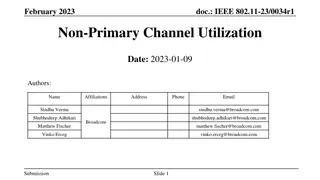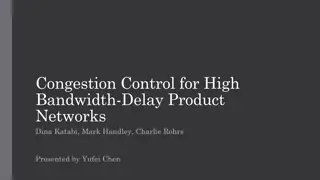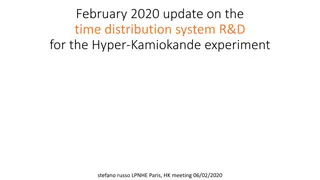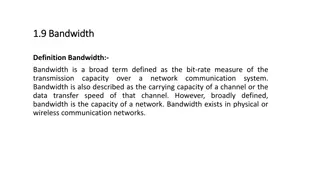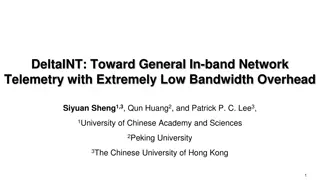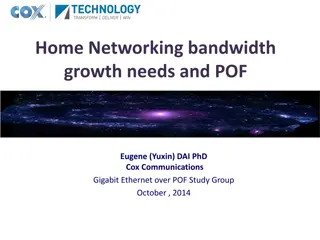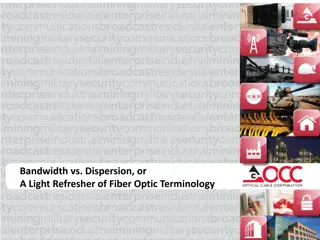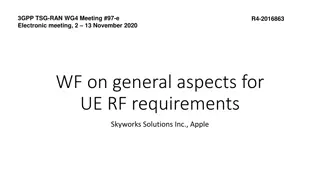Optimized Content Transfer in Mesh Networks Using Bandwidth-Aware Chunking
This presentation by Gurdev Singh from Samsung addresses a technique for optimized content transfer in mesh networks by splitting content into file chunks based on the bandwidth of the channel. By considering the bandwidth or link quality of destination nodes, the content is divided so that lower bandwidth channels can be efficiently utilized. The proposed solution involves assigning appropriate file chunks to suitable bandwidth connections to enhance network throughput and reduce packet delays.
Download Presentation

Please find below an Image/Link to download the presentation.
The content on the website is provided AS IS for your information and personal use only. It may not be sold, licensed, or shared on other websites without obtaining consent from the author.If you encounter any issues during the download, it is possible that the publisher has removed the file from their server.
You are allowed to download the files provided on this website for personal or commercial use, subject to the condition that they are used lawfully. All files are the property of their respective owners.
The content on the website is provided AS IS for your information and personal use only. It may not be sold, licensed, or shared on other websites without obtaining consent from the author.
E N D
Presentation Transcript
July 2020 doc.: IEEE 802.11-20/1007r0 Optimized content transfer in mesh network Date: 2020-07-13 Authors: Name Gurdev Singh Affiliations Address Samsung Phone +91- 9818643933 email Gurdev.s@samsung.com Samsung Research Institute, Plot No- 2A, Sector 126, Noida, UP, India Submission Slide 1 Gurdev Singh, Samsung
July 2020 doc.: IEEE 802.11-20/1007r0 Abstract This presentation addresses a technique for optimized content transfer in mesh network. It suggests a way to split the content to be transferred into file chunks considering the bandwidth of the channel. The bandwidth (link quality) of destination nodes is calculated first and then content is split into chunks so that lower bandwidth channels can be utilized efficiently. In a unit time, a larger size chunk will propagate on high bandwidth, a smaller chunk will propagate on lower bandwidth channel. Submission Slide 2 Gurdev Singh, Samsung
July 2020 doc.: IEEE 802.11-20/1007r0 Problem Statement In a mesh network, downloading data quickly to all nodes is time consuming. Simultaneous download cause congestion and decrease network throughput resulting in unacceptable packet delays. Duplicate packets transfer in mesh network throughput degrade. Submission Slide 3 Gurdev Singh, Samsung
July 2020 doc.: IEEE 802.11-20/1007r0 Currently two ways of downloading, (a) Download and Forward Mode Problem1: The longer the device network, more time it takes to reach to last node. Submission Slide 4 Gurdev Singh, Samsung
July 2020 doc.: IEEE 802.11-20/1007r0 Currently two ways of downloading, (b) Simultaneous download from server Problem2: All the devices downloading from server in mesh, results in bandwidth degradation. Submission Slide 5 Gurdev Singh, Samsung
July 2020 doc.: IEEE 802.11-20/1007r0 Proposed Solution Divide the file into chunks on the basis of node link quality & transfer on appropriate path. In a unit time, a larger chunk will reach to a good bandwidth node, in same time, a smaller chunk will reach to a lower bandwidth node. Algorithm will assign appropriate file chunk to suitable bandwidth connection 2 10 MB Content 5MB Chunk 40Mb/s 40Mb/s 40Mb/s P1 (5MB, 3MB, 2MB) P2 P3 P4 10 MB file is split to bandwidth (5MB, 3MB, 2MB) considering bandwidth 1 3MB Chunk 24Mb/s 24Mb/s 2MB Chunk 16Mb/s Note: What is being shown above is not multicast but TCP/IP transfer. Submission Slide 6 Gurdev Singh, Samsung
July 2020 Bandwidth strength table (for the nodes on selected path) doc.: IEEE 802.11-20/1007r0 Proposed method suggests an optimization on Link State Routing by utilizing the channels of less Link quality which exists among the selected nodes for best path. The smaller data chunks will propagate on less efficient paths. The file chunk will be created that are best suitable for low bandwidth. NBS table contains information about bandwidth of nodes. Best Path is detected using Link Quality assessment Out of shortlisted nodes, detect the path of lower Link quality as well. Create Bandwidth Strength table using Link Quality. (NBS Table) 1 2 3 16Mb/s No of connections 24Mb/s 24Mb/s 3 40Mb/s Connection Graphs 40Mb/s P1 P2 P3 P4 40Mb/s P1 P2 40Mb/s P1 P3 24Mb/s P1 P4 16Mb/s P2 P1 40Mb/s P2 P3 40Mb/s P2 P4 24Mb/s P3 P1 24Mb/s P3 P2 40Mb/s P3 P4 40Mb/s P4 P1 16Mb/s P5 P6 P7 P4 P4 P2 P3 24Mb/s 40Mb/s Submission Slide 7 Gurdev Singh, Samsung
July 2020 doc.: IEEE 802.11-20/1007r0 How it works (1) - Create NBS Table 16Mb/s 24Mb/s 24Mb/s 1 Create NBS table 40Mb/s 40Mb/s 40Mb/s P1 P2 P3 P4 No of connections No of connections No of connections No of connections 3 3 3 3 Connection Graphs Connection Graphs Connection Graphs Connection Graphs P1 P1 P1 P2 P2 P2 P3 P3 P3 P4 P4 P4 P2 P3 P4 P1 P3 P4 P1 P2 P4 P1 P2 P3 40Mb/s 24Mb/s 16Mb/s 40Mb/s 40Mb/s 24Mb/s 24Mb/s 40Mb/s 40Mb/s 16Mb/s 24Mb/s 40Mb/s P2 P2 P2 P1 P1 P1 P3 P3 P3 P4 P4 P4 P1 P3 P4 P2 P3 P4 P1 P2 P4 P1 P2 P3 40Mb/s 40Mb/s 24Mb/s 40Mb/s 24Mb/s 16Mb/s 24Mb/s 40Mb/s 40Mb/s 16Mb/s 24Mb/s 40Mb/s P3 P3 P3 P2 P2 P2 P1 P1 P1 P4 P4 P4 P1 P2 P4 P1 P3 P4 P2 P3 P4 P1 P2 P3 24Mb/s 40Mb/s 40Mb/s 40Mb/s 40Mb/s 24Mb/s 40Mb/s 24Mb/s 16Mb/s 16Mb/s 24Mb/s 40Mb/s P4 P4 P4 P2 P2 P2 P3 P3 P3 P1 P1 P1 P1 P2 P3 P1 P3 P4 P1 P2 P4 P2 P3 P4 16Mb/s 24Mb/s 40Mb/s 40Mb/s 40Mb/s 24Mb/s 24Mb/s 40Mb/s 40Mb/s 40Mb/s 24Mb/s 16Mb/s NBS table NBS table NBS table NBS table Submission Slide 8 Gurdev Singh, Samsung
July 2020 How it works (2) - Download the content on First Node doc.: IEEE 802.11-20/1007r0 10 MB Content 24Mb/s 24Mb/s 40Mb/s 40Mb/s 40Mb/s P1 2 P2 P3 P4 Download content file (10 MB) No of connections No of connections No of connections No of connections 3 3 3 3 Connection Graphs Connection Graphs Connection Graphs Connection Graphs P1 P1 P1 P2 P2 P2 P3 P3 P3 P4 P4 P4 P2 P3 P4 P1 P3 P4 P1 P2 P4 P1 P2 P3 40Mb/s 24Mb/s 16Mb/s 40Mb/s 40Mb/s 24Mb/s 24Mb/s 40Mb/s 40Mb/s 16Mb/s 24Mb/s 40Mb/s P1 P1 P1 P2 P2 P2 P3 P3 P3 P4 P4 P4 P2 P3 P4 P1 P3 P4 P1 P2 P4 P1 P2 P3 40Mb/s 24Mb/s 16Mb/s 40Mb/s 40Mb/s 24Mb/s 24Mb/s 40Mb/s 40Mb/s 16Mb/s 24Mb/s 40Mb/s P1 P1 P1 P2 P2 P2 P3 P3 P3 P4 P4 P4 P2 P3 P4 P1 P3 P4 P1 P2 P4 P1 P2 P3 40Mb/s 24Mb/s 16Mb/s 40Mb/s 40Mb/s 24Mb/s 24Mb/s 40Mb/s 40Mb/s 16Mb/s 24Mb/s 40Mb/s P1 P1 P1 P2 P2 P2 P3 P3 P3 P4 P4 P4 P2 P3 P4 P1 P3 P4 P1 P2 P4 P1 P2 P3 40Mb/s 24Mb/s 16Mb/s 40Mb/s 40Mb/s 24Mb/s 24Mb/s 40Mb/s 40Mb/s 16Mb/s 24Mb/s 40Mb/s NBS table NBS table NBS table NBS table Submission Slide 9 Gurdev Singh, Samsung
July 2020 doc.: IEEE 802.11-20/1007r0 How it works (3) - Split the content 10 MB Content 16Mb/s 24Mb/s 24Mb/s 40Mb/s 40Mb/s 40Mb/s P1 Split the file on the basis of bandwidth P2 P3 P4 3 (5,3,2) No of connections No of connections No of connections No of connections 3 3 3 3 Connection Graphs Connection Graphs Connection Graphs Connection Graphs P1 P1 P1 P2 P2 P2 P3 P3 P3 P4 P4 P4 P2 P3 P4 P1 P3 P4 P1 P2 P4 P1 P2 P3 40Mb/s 24Mb/s 16Mb/s 40Mb/s 40Mb/s 24Mb/s 24Mb/s 40Mb/s 40Mb/s 16Mb/s 24Mb/s 40Mb/s P1 P1 P1 P2 P2 P2 P3 P3 P3 P4 P4 P4 P2 P3 P4 P1 P3 P4 P1 P2 P4 P1 P2 P3 40Mb/s 24Mb/s 16Mb/s 40Mb/s 40Mb/s 24Mb/s 24Mb/s 40Mb/s 40Mb/s 16Mb/s 24Mb/s 40Mb/s P1 P1 P1 P2 P2 P2 P3 P3 P3 P4 P4 P4 P2 P3 P4 P1 P3 P4 P1 P2 P4 P1 P2 P3 40Mb/s 24Mb/s 16Mb/s 40Mb/s 40Mb/s 24Mb/s 24Mb/s 40Mb/s 40Mb/s 16Mb/s 24Mb/s 40Mb/s P1 P1 P1 P2 P2 P2 P3 P3 P3 P4 P4 P4 P2 P3 P4 P1 P3 P4 P1 P2 P4 P1 P2 P3 40Mb/s 24Mb/s 16Mb/s 40Mb/s 40Mb/s 24Mb/s 24Mb/s 40Mb/s 40Mb/s 16Mb/s 24Mb/s 40Mb/s NBS table NBS table NBS table NBS table Submission Slide 10 Gurdev Singh, Samsung
July 2020 How it works (4) Find suitable chunk, Initiate Transfer doc.: IEEE 802.11-20/1007r0 2MB Chunk 16Mb/s 4 3MB Chunk 24Mb/s 24Mb/s Initiate transfer 5MB Chunk 40Mb/s 40Mb/s 40Mb/s P1 P2 P3 P4 10 MB Content (5,3,2) Legends Time interval (in Sec) 1 2 3 4 5 P1 P2 P3 P4 Downloading 5,3,2 Node 5 3 2 5,3 5,3,2 3,5 3,5,2 2,3 2,3,5 Mission: make 10 MB content available to all 4 nodes NCA Table NBS Table Download completed in 5 sec Submission Slide 11 Gurdev Singh, Samsung
July 2020 doc.: IEEE 802.11-20/1007r0 Structure of NBS & NCA Table Node Bandwidth Strength (NBS) table Node Content Availability (NCA) table No of connections No of Nodes 3 4 Connection Graphs P1 P1 P1 P2 P2 P2 P3 P3 P3 P4 P4 P4 P2 P3 P4 P1 P3 P4 P1 P2 P4 P1 P2 P3 40Mb/s 24Mb/s 16Mb/s 40Mb/s 40Mb/s 24Mb/s 24Mb/s 40Mb/s 40Mb/s 16Mb/s 24Mb/s 40Mb/s Nodes File Part and Availability FP1 (5MB) FP2(3MB) FP3(2MB) P1 Y Y Y FP1 (5MB) FP2(3MB) FP3(2MB) P2 Y N N FP1 (5MB) FP2(3MB) FP3(2MB) P3 N Y N FP1 (5MB) FP2(3MB) FP3(2MB) P4 N N Y NCA table at T3 i.e. third cycle of chunk transfer NBS table will be created from Link Metric for best path nodes. NBS will contain the alternative path as well along with best path but only for the nodes of best path. This table entries will be used to split the content (file) to subparts (chunks) NCA table will contain the information about which file part (chunk) is available on which node. This table information will be broadcasted to whenever a node completes the chunk downloading. Submission Slide 12 Gurdev Singh, Samsung
July 2020 doc.: IEEE 802.11-20/1007r0 Visualization Chunk downloading . Submission Slide 13 Gurdev Singh, Samsung
July 2020 doc.: IEEE 802.11-20/1007r0 Improvements File splitting approach (proposed) Legacy approach (Download and forward) Time interval (in Sec) 1 2 3 4 5 Time interval (in Sec) 1 2 3 4 5 6 7 8 P1 P2 P3 P4 P1 P2 P3 P4 Downloading 5,3,2 Downloading 10MB 5 3 2 Downloading 10MB 1 5,3 5,3,2 3,5 3,5,2 2,3 2,3,5 Downloading 10 MB Mission: make 10 MB content available to all 4 nodes Downloading 10 MB ~ 40% improvements Time interval (in Sec) 1 2 3 4 5 6 7 Time interval (in Sec) 1 2 3 4 5 6 7 8 9 10 11 12 13 14 15 P1 P2 P3 P4 P5 Downloading Downloading 11MB P1 P2 P3 P4 P5 Downloading Downloading Downloading 11MB Downloading 5,3,2,1 2 5 5 3 3 2 2 1 1 Downloading Downloading 11 MB 5,3 5,3,2 5,3,2,1 3,5 3,5,2 3,5,2,1 2,3 2,3,5 2,3,5,1 1,2 1,2,3 1,2,3,5 Downloading Downloading 11 MB Mission: make 11 MB content available to all 5 nodes Downloading Downloading 11 MB 50% improvements Submission Slide 14 Gurdev Singh, Samsung
July 2020 Advantages Reduced congestion and duplicate packets doc.: IEEE 802.11-20/1007r0 Submission Slide 15 Gurdev Singh, Samsung
July 2020 doc.: IEEE 802.11-20/1007r0 Implementation details 4 5 1 File 2 3 Make Alternate Path Use selected nodes, create path which are having lesser Link Quality. Create Link Metric (NBS) Split file to chunks Read NBS table and split the file to chunks on the basis of bandwidth at one node. Identify Link Quality Bandwidth of one nodes to other node on Mesh network Make Best Path Select a best path by assessing link quality. List nodes of best path. distribution request initiated 7 6 8 9 10 Update the location of Chunk Chunk download successful > update NCA table Start chunk transfer Assign appropriate chunk suitable for bandwidth Broadcast NCA table Make file Chunk location information available to all. Find next chunk Find Chunk location from NCA table & transfer chunk Consume File Merge all chunks and make original file. Submission Slide 16 Gurdev Singh, Samsung
July 2020 doc.: IEEE 802.11-20/1007r0 Flow chart Start Check the node with best bandwidth with content server, term this as Gateway node Content Transfer initiated Download content to Gateway node Link State Routing initiated for path No Link quality assessment Content download finished on gateway node ? Create best path for content transfer Link Metric created Yes Get Bandwidth strength from NBS table & Split content file into chunks Check alternative paths within best path node Add headers to file parts (Sequence No, Hash Key) Create Path List with lesser bandwidth C1 Marked Link Metric NBS Table Submission Slide 17 Gurdev Singh, Samsung
July 2020 doc.: IEEE 802.11-20/1007r0 Flow chart Adjust Routing with Capping as per bandwidth from NBS C1 Does all file parts download complete ? Yes Scan suitable bandwidth channel for file part transfer No Check missing part on node, Scan NCA Table to find the availability of missing file-part on a nearby node No Is file-part suitable for channel bandwidth Yes Is Required file-part location found ? No Yes Initiate file part transfer, file part received on node. Node Content availability NCA Table Update file part availability on NCA Table Check file-part header and assemble content file. Broadcast Content Table NCA Stop Submission Slide 18 Gurdev Singh, Samsung
July 2020 doc.: IEEE 802.11-20/1007r0 References 1. Multi-Hop Dilemma https://www.semanticscholar.org/paper/Solving-the-Wireless-Mesh-Multi-Hop- Dilemma/122652dc85cc0bcfeba921de61f99045317b29fe 2. Mesh networking challenges in downloading https://ieeexplore.ieee.org/stamp/stamp.jsp?arnumber=6761320 3. Latency in information delivery https://www.researchgate.net/publication/314719782_80211s_QoS_Routing_for_Telemedicine_Service 4. Delay in synchronization http://www.strixsystems.com/products/datasheets/strixwhitepaper_multihop.pdf 5. A New Link Scheduling Algorithm for Concurrent Tx/Rx Wireless Mesh Networks https://ieeexplore.ieee.org/document/4533610 Submission Slide 19 Gurdev Singh, Samsung
July 2020 doc.: IEEE 802.11-20/1007r0 Thanks Submission Slide 20 Gurdev Singh, Samsung





